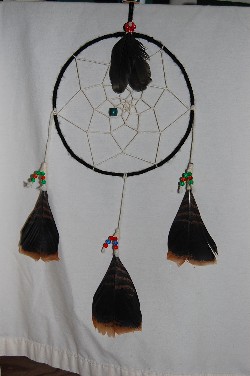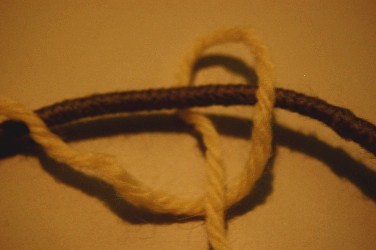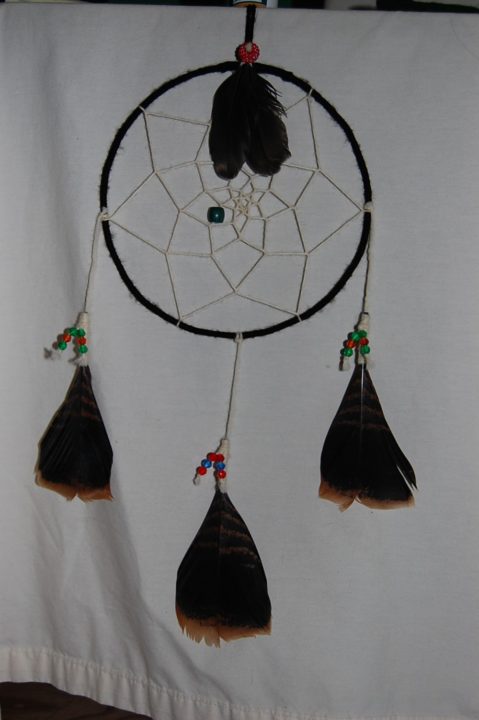Making a Dream Catcher
Today was the Granger Homestead old fashion fun day, but unfortunately the weather didn’t cooperate. It was basically a steady rain, so about 1:00 many of us packed up and went home to dry off. I guess Mother Nature wanted to prove she still has dominion over us humans. It was pretty cool seeing so many people walking around in their period costumes though. Someone even had hammer dulcimers to make music. If only the sun had been shining! Oh well, we can’t control the weather.

The wild turkey I ended up hitting was actually pretty good eating. There was a little bruising, but most of the meat was fine. It tastes different than farm raised turkey. It was dryer meat (just the way I like it), and was sort a mix between turkey and roast beef as far as taste. My grandmother said she once cooked a wild goose that tasted just like roast beef, strangely enough.
Well, due to getting ready for the double weekend, I didn’t have time to post a craft project on Friday, so I’ll post it here. Having gotten lots of beautiful feathers from the unfortunate accident with the turkey, I’ve been making dream catchers all week; so naturally, this week’s project is a dream catcher.
The web weaving is a bit tricky the first time or two, but once you get the hang of it, it falls into a sort of relaxing rhythm until you can practically make them with your eyes closed. Ok, maybe not with your eyes closed, but you get the idea; once you get the knack, it all falls into place.
The best part is, dream catchers aren’t just a myth, they actually work. I never have bad dreams when there’s a dream catcher hanging over my bed. So while I very much apologize to the poor turkey, I do thank her for the supper and the beautiful feathers.
Dream catchers are both beautiful and functional. When hung above one’s place of sleep, they are said to protect a person from nightmares.
You will need:
- A wooden or metal hoop
- Roughly 3 yards of yarn or leather string
- 1 yard of white string for the interior
- Beads
- Feathers
Dream catchers are a craft originating with the Ojibway Native American tribe. They were often woven for newborns by grandparents, to protect the children from nightmares. While the traditional dream catcher is Native American, the concept of objects to protect a sleeper from bad dreams in universal. Many cultures throughout the world have their own ways prevent bad dreams.
The Native American dream catcher consists of a hoop, within which is woven a “web,” and feathers dangling off the ends. This dream catcher is hung over one’s bed. Good dreams pass through the center hole in the web, trickling down the feathers into the sleeper’s head. Bad dreams get stuck in the web and disintegrate when they are touched by the first rays of the morning light.
To begin making a dream catcher, you will need to start with a hoop. Traditional dream catchers were made with wooden hoops (willow often works well due to it’s suppleness), but today, many dream catchers are made on metal hoops. Craft shop carry ready made metal hoops, but a cheaper solution is to fashion a hoop out of bailing wire (one of my favorite crafting mediums), or another strong wire.
Once you have your hoop, it is time to wrap the edges. (If you are using a wooden hoop, and prefer to have the wood showing, skip this step). Many dream catchers are wrapped with leather, but yarn can be just as attractive, particularly for a child’s dream catcher as the bright colors available in yarn can be quite appealing. To achieve a leather look, I often use strips of Avola (a suede like material) as an inexpensive alternative to real leather. Wrap the entire hoop in your chosen wrapping, tying off the end in a loop.

To begin the web, tie a piece of white string to the top of the hoop. Pull it a couple inches to the right (or left if you’re a lefty). This will form a space between the string and the hoop. Pull the string over the top of the hoop dropping down behind the hoop, then through the space. Pull taut. Repeat until you reach the last space.
The last space should be about half the size of the others. Instead of pulling the string through the space, this time, pull it through the center of the first loop you made. Continue on with the third, fourth, and so on. A star-like pattern will begin to form.
When you near the center of the web, slip a single bead onto string, but continue weaving the center of the loops as normal. The bead will fall into place on it’s own. Some people like to have beads covering the webs of their dream catchers, but traditionally only one bead was used. This bead represented the spider of the web.
When you reach the middle, tie off the string. There will be a small hole in the center of the web; this is where the good dreams crawl through.
Tie three pieces of string to three feathers, sliding a few beads down each shaft. Tie these three feathers to the bottom of the dream catcher. You can add a few feathers to the top of the dream catcher as well, or wherever else you desire.
Hang your dream catcher above your sleeping place and enjoy.
By Amber Reifsteck, The Woodland Elf
The information provided on this website is for general information purposes only. If you choose to rely on the information on this website, you do so at your own risk and you assume responsibility for the results. (Full disclaimer here)
Enjoy this post? Click here to subscribe by email and get new posts delivered to your inbox.Ads by Google







